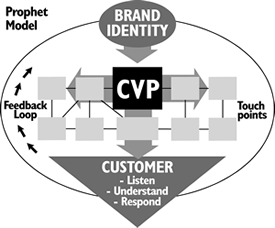Are brands dead? Well, some are. Brand building, on the other hand, is very much alive and more critical to a company's success than ever. Unfortunately, many companies fail to understand how to create and shepherd strong brands. The days of brand building defined simply by awareness and driven by marketing alone are over. Visionary companies recognize that responsibility for brand management belongs with the organization as a whole.
THERE'S NO ESCAPING YOUR BRAND
A brand is the collective experience of your key constituencies-customers, suppliers, investors, and employees-and is defined more by deeds than by words. It's what your company stands for and how it behaves with each of these groups. Which is why developing a brand-customer relationship is so important-either you make the customer experience or it gets made without you.

To create a successful brand-customer relationship, you must develop a compelling brand identity and customer value proposition, rely on customer perspective, and have the ability to listen and respond appropriately to evolve your company's offerings to meet customers' needs and desires.
A strategy is not enough either. The organization must be aligned in ways that anticipate and fulfill customers' emotional expectations at every touch point to create meaningful relationships and lasting competitive advantage.
BRAND IDENTITY-THE TOUCHSTONE
A brand identity is the centering idea of an organization. It captures that which you'd like to become, giving the organization something to aspire to. A common pitfall for many companies is not taking the time to think about who they are or what kinds of companies they want to become. While it may be easy to articulate revenue goals, developing a brand identity requires a different thinking process.
A brand identity should be focused on customer benefits, differentiated from competitors, and of course, given the organization's capabilities, possible. Once defined, the brand identity becomes the organization's centering set of associations that it continually strives to create or maintain.
CUSTOMER VALUE PROPOSITION-THE MARCHING ORDERS
A successful customer value proposition clearly communicates the brand's functional, emotional, and self-expressive benefits. It is delivered in a way that is superior or unique when compared to competitors. While a brand identity is a big-picture vision, the value proposition provides the strategy for reaching that vision, linking the brand to the customer experience.
Here is another place where companies go astray. Organizational structures often prevent creation of a relevant, holistic customer experience. For example, departmental goals can too often take precedence and end up disconnected from the brand. A value proposition must be integrated across the organization so that every functional area contributes to the overall customer experience.
CUSTOMER PERSPECTIVE-THE CONTINUOUS THREAD
Customer experience is shaped by a series of interactions with an organization. What products or services are offered? Does the package arrive on time? Does the help desk answer the phone promptly? If you don't take a customer perspective when creating the customer experience, you'll make it much easier for a competitor to copy your product or service and steal market share. You should always base the brand-customer relationship on an outside-in perspective, creating a customer-centric experience.
LISTEN, UNDERSTAND, RESPOND-THE WAY TO GROW
The final ingredient that binds a customer to your brand in a lasting relationship is dialogue. Your company's brand isn't a monolithic, hermetic face that the organization presents to the world. Rather, it's an ongoing exchange where you listen carefully to your customers, understand what they say, and respond by modifying your value proposition and extending your businesses appropriately to fulfill customers' desires.
A BRAND THAT WORKS
Hard work? Yes. The payoff however can be counted in high customer satisfaction, sales, and revenue. For example, before launching an online store, Williams-Sonoma wanted to ensure that the customer's online experience was consistent with the catalog and retail brand experience it had carefully crafted. The company defined new business processes so that every functional area supported the new channel. This meant working with merchandising, inventory management, call center, distribution center, database marketing, and financial reporting areas to make sure that the mail order systems, retail systems, and web site worked together. Distribution center and retail employees were trained to ensure that customers had virtually the same experience with the Williams-Sonoma site as they did in a physical store. The firm exceeded its revenue goals and has been able to significantly grow its business in this specific channel.
A brand-customer relationship is the bedrock on which great companies rise, or mismanaged, it's the chalk on which mediocre companies fail. Great brands that aspire to perfect touch points create the coherent experience to which customers respond. If you fail, you'd better watch your back.




